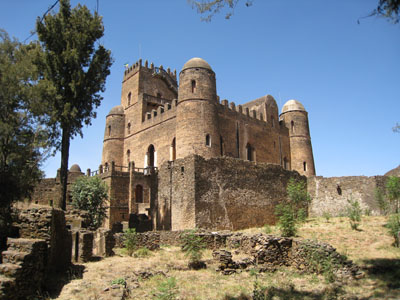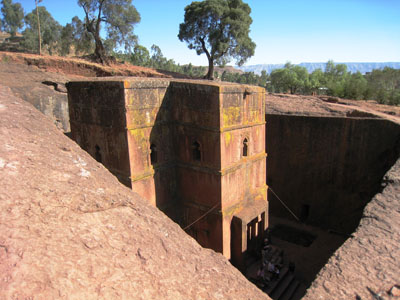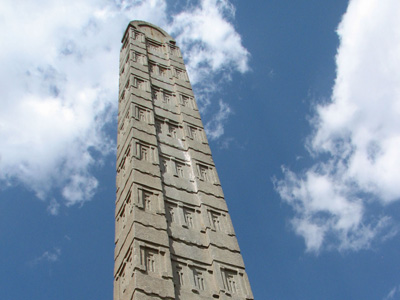Day Excursion
1. CITY TOUR OF ADDIS ABABA
Founded in 1886 by Emp. Menelik II, Addis Ababa is the capital of Ethiopia and the seat of the African Union (AU). Addis Ababa is the third highest capital in the world and one of the largest cities in Africa with a population well over 5 million. It is located at 2500 m above sea level at the foot step of the highest peak of Entoto Mountain chain (3200m above sea level), and enjoys an excellent climate all year round; with an average temperature of 160C. Addis Ababa is a pleasant city with wide avenues of Jacarandas, interesting museums and one of the largest open-air markets in Africa, known as Merkato.
Any FOUR of the following attractions are considered to be full day city tour of Addis Ababa:-
National Museum:- It comprises of many archaeological and historical findings including the famous complete hominid fossil remain of ‘Lucy’ locally known as ‘Dinknesh’ meaning wonderful. Visiting this museum is having a good summary for your visit to the historic Ethiopia.
Ethnological Museum:- It is found in the main campus of the Addis Ababa University by the Institute of Ethiopian Studies with the aim to preserve the country's historical and cultural heritages. It has complete collections that describe almost all the tribal groups in Ethiopia. Here you will have an overview about the history, culture and traditions of the people of Ethiopia. The collections include the nomadic tribal groups that are now living just as man's forefather lived thousands of years back.
Trinity Cathedral:- a beautiful church with a baroque style of European architecture which is unique to both Ethiopia and Africa and is dedicated to the Holly Trinity. Here you will find scripts of the imperial families, statues done by a Greek sculpture, Stained glass window paintings from the Old and New Testament in the Bible and coffins of Emperor Haile Silassie-I; the founder of the church, and his wife.
Merkato:- It is the largest open-air market in Africa. Here you will be presented with confusing, but fascinating, glimpse of the vast range of goods and artifacts available from all parts of the country and you will enjoy the Ethiopian trade exchange tradition in the open air, you can purchase any thing you desire here.
St. George Cathedral: The church of St. George is a very traditionally structured building. Menelik II following his victory over the Italians at the Battle of Adwa built the octagonal church in 1896. St. George the dragon killer was the patron saint of soldiers and it is to him that the church is dedicated. In St. George church, the most interesting thing is the artwork of both modern and traditional church painting.
Mount Entoto:- It is the highest peak in Addis with an altitude of 3200 meters, which was the site for the first palace of Emperor Menelik-II, the founder of Addis Ababa. Here there is St. Mary church, where Emperor Menelik crowned Emperor in it and you will admire the stupendous views of the city with its surrounding plains and volcanic cones together with its breathtaking air.
Lion Park:- This small but captivating park is located a few hundred meters down from the Addis Ababa University Sidest Kilo campus. In this lion cage, you can see graceful caged lions devouring large chunks of meat and where you can take your pictures standing beside them.
Zoological Museum:- The Zoological Natural History museum was established at the then University College of Addis Ababa in 1955. Since then, it has remained the only natural history museum in the country. It is located in the science faculty compound and houses Specimens of more than 1100 species of animals. These specimens were collected by Mr. S. Patrizi during the time of Italian occupation, and staff and students of the Department of Biology and various researchers who worked in Ethiopia in collaboration with the Biology Department.
Pottery: Is one of the cottage industries and it is a means of producing house hold utensils from clay mud where it is available. Poetry is normally done by women like other African nations. Here, you can see the whole process of making a poetry, which means, making, drying, and firing to make it strong and durable.
Weaving: This is the making cultural clothes with different designs in a traditional way. Here you can see while the weavers are weaving and selling the products in the nearby to their weaving place. The main produces are the traditional Shema Clothes like Gabi, Netela, and so on from cotton, which are completely in different style with other industrially, make nylon clothes. The national cloth is also made in the same way. Even if weaving is the activity that can be done in every part of the country, there are people who are specialized for this activity and making cultural clothes with a quality in many different forms. These are Dorze people, one of the Southern nations and Nationalities who are known also by beehive shaped houses that when practically seen looks like more an elephant head. In Addis Ababa, they are leading in supplying the cultural clothes.
PATRIARCHATE MUSEUM and LIBRARY
This recently modernized museum was established in 1996 EC ‘ to preserve and protect the heritage of past religious leaders and preserve religious icons and items’. The museum ( /the Ethiopian Tewahdo Orthodox Church Patriarchate Museum & Library ) is located at the Patriarchate Office and close to the National Museum of Ethiopia.
This purposefully rebuilt museum on the premises of the old Patriarchate residence also includes a well-organized library of religious books and manuscripts for researchers and lay visitors alike.
The museum includes various artefacts including manuscripts ( Brana) religious icons and materials, wood carved religious icons and paintings, pictures of past religious leaders, as well as robes. The items were acquired through donations by past religious leaders ( Patriarchs, Archbishops etc..) , members of the nobility and other individuals. Items are well kept in new showcases, has lifts to its upper chambers ; items are numbered and captioned with a central catalogue. It is protected by CCTV cameras as well as physical guard protection externally.
Museum is open every working day except weekends, with plan to open it on weekends in the near future. Museum staff assist in explaining collection and are helpful for group visiting groups.An entrance fee of 1 birr for students 3 birr for adults and 25 birr for foreigners
Price for the above city tour ( any four of the listed visits) is:-
1 Pax = USD 176 per person
2 Pax = USD 102 per person
3 Pax = USD 73 per person
4 Pax = USD 59 per person
5 Pax = USD 67 per person
Above 5 pax = USD 61 per person
Price includes the following services ONLY:-
- Entrance fees
- Transportation
- English speaking guide service
2. EXCURSION TRIPS
Addis- Menagesha Suba Forest- Addis
After breakfast drive to the western outskirt of Addis Ababa to Menagesha forest. It is the mountainous area having the shape of an upside down pudding basin and is covered more or less entirely in thick heath and on the other side it is fully covered with indigenous trees which becomes a habitat for endemic species of birds and animals. Late after noon drive back to Addis.
ADDIS / Debre-Zeit / Lake-Koka / Lake-Ziway / ADDIS
After breakfast drive to Debre Ziet to visit the Crater Lakes with their bird life. Proceed through the rift-valley region to artificial Lake of Koka to spot various species of birds. Continue driving to Lake Ziway- (the largest Northern Ethiopian rift-valley Lake, it is the home of 5 little volcanic Islands) here you will spot various species of water birds. Drive back to Addis.
Melka Kunture, Adadi Mariam & Tiya
Duration: Full-Day
AM, depart south-west of Addis Ababa for visiting:
Melka-Kunture (50km) where fossils of pre history age and more than 1.5 million years stone tools have been discovered.
Adadi Mariam Cave Church (17km further) believed to date back to the 13th century and gives a good indication of the Lalibela 12th century rock-hewn churches.
35 km drive from turn-off to Adadi Maryam you reach Tiya Stelae Fields where prehistoric monoliths somewhat similar to the Axum stelae are seen.
Picnic lunch en-route and afternoon easy drive back to Addis Ababa.
Excursion trip to Blue Nile Gorge
After breakfast, head north of Addis Ababa to passing Sululta Plains. Our first stop will be the Debre Lobanos Monastery. 103 KM. to the north from Addis Ababa, a right hand turn leads to the ancient monastery of Debre Libanos. This is the beginning of the true gorge country for which the central highlands are renowned. Breath-taking views over chasms with a depth of 2,000 ft. or more. The old monastery itself is situated behind the new church to the right high up on the cliff. The first Abbot of the monastery was one Tekle Haymanot (1260) later canonized. The new church stands beneath a cliff on the edge of the gorge. It has beautiful stained glass windows and before you enter, it is worth noting the mosaic figures on the façade. You can stop and spread a picnic lunch halfway between the turn off and the church. Gregarious gelada baboons peer curiously at the visitor while birds of prey soar overhead.
Further drive north and visit the Blue Nile gorge. The great Blue Nile River flows out of Lake Tana and cascades over the famous Blue Nile Falls (Tis Issat), then winds for about 500 km. through some of the most spectacular gorge country in the world. For centuries the river formed the natural barrier between Shewa and Gojam, but now a modern bridge spans the turbulent water. There are guards on the bridge and photographing is forbidden.
Ambo & Wenchi Crater Lake
Duration: Full-Day
The road to Ambo (125km west of Addis) takes you through the capital’s water supply reservoir Gefersa where a range of bush and wetland bird species including as many as a quarter of Ethiopia's 29 endemic birds are found. To reach the Crater Lake Wenchi drive further 27km from Ambo. Walk or mule ride roughly 2km to the crater rim and after enjoying the wonderful views of the surrounding countryside return to Ambo town, have lunch and relax swimming in the hot mineral water pool before driving back to Addis Ababa.
Ankober
Duration: Full-Day
The road to Ankober passes through impressively rugged scenery and after about 130km drive you reach Debre Berhan town where you'll have a coffee break and then drive further a few km, turn on the gravel road and drive zigzagging along several hills scattered all over the cultivated plateau. The gravel road leads to the lofty massive mountain known as Kundi (over 3500 masl) overlooking the Great Rift Valley. From this chilly height covered with eucalyptus forest you may trek down to Ankober Palace Lodge (2870 masl) where you’ll have your lunch enjoying the wonderful scenery.
After lunch before driving back to Addis visiting one of the surrounding churches with its artifacts as well as poetry and music school may give you an insight into the life of the Ethiopian Orthodox Church in the countryside.
Addis - Awash National Park - Addis
After breakfast, drive to Awash National Park and enjoy a game drive in park and you will have a game drive to visit mammals and birds: -The park’s name comes from one of the longest river in Ethiopia: the Awash. This park is the oldest and most developed wildlife reserve in Ethiopia. It is even easy to access. Awash National Park occupies about 830 square kilometres (320 miles) of dry savannah in the middle of the Rift Valley. This hot, arid terrain climbs up to 1000 meters (600 feet) above sea level, with the exception of the peak of Fentale volcano, which reaches 2007 meters (1200 feet). Temperatures in the park are hot and can reach as high as 420 C (1070 F) Nights are cooler, with temperatures between 100 C & 220 C (500 C & 720 F). Rain mainly falls between February and April, and June to August, and averages 619 mm (24 inches).
Awash national park has over 350 species of bird that have been recorded in this savannah grassland. Here you will also visit the Awash River Falls. Drive back to Addis through Ethiopian Great Rift Valley Region and visit Beseka Crater Lake.
Price for any one of the above excursions is:-
Price for the above city tour is:-
1 Pax = USD 281 per person
2 Pax = USD 171 per person
3 Pax = USD 134 per person
4 Pax = USD 115 per person
5 Pax = USD 110 per person
Above 5 pax = USD 103 per person
Price includes the following services ONLY:-
- Entrance fees
- Lunch
- Transportation
- English speaking guide service










